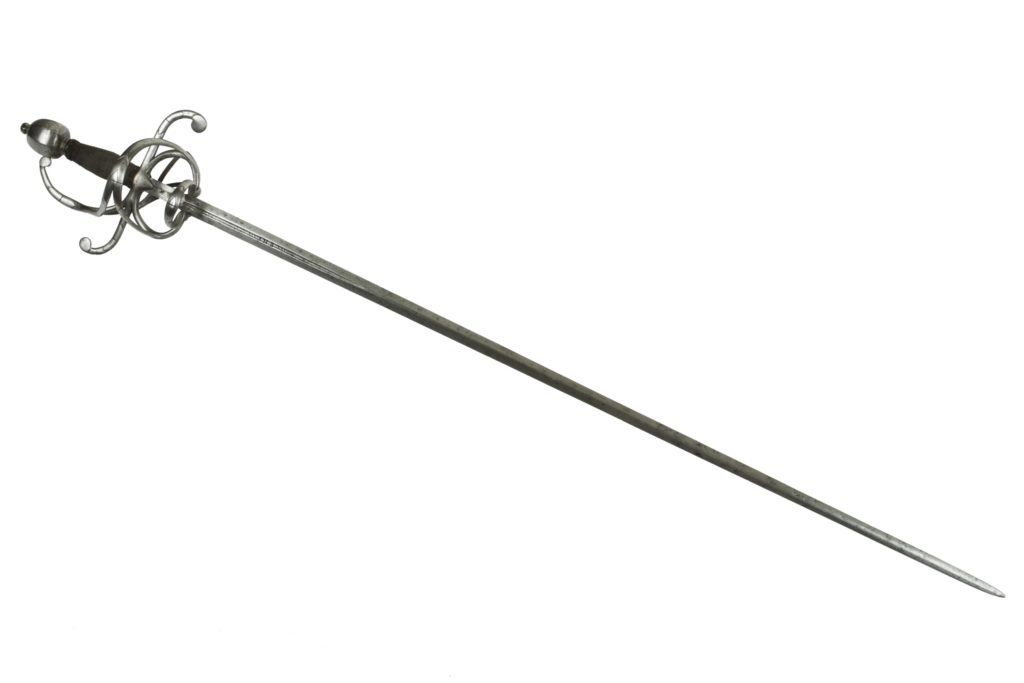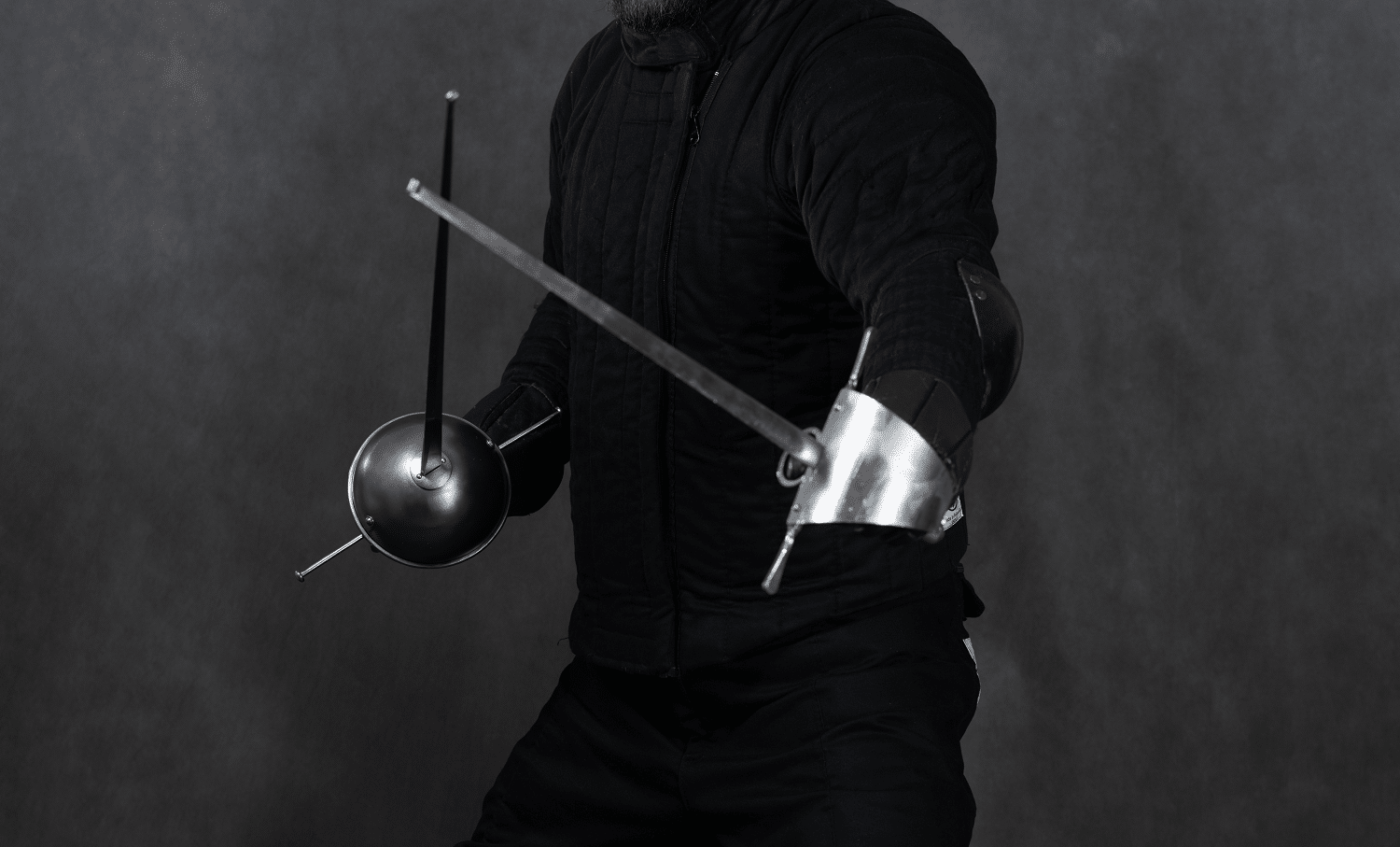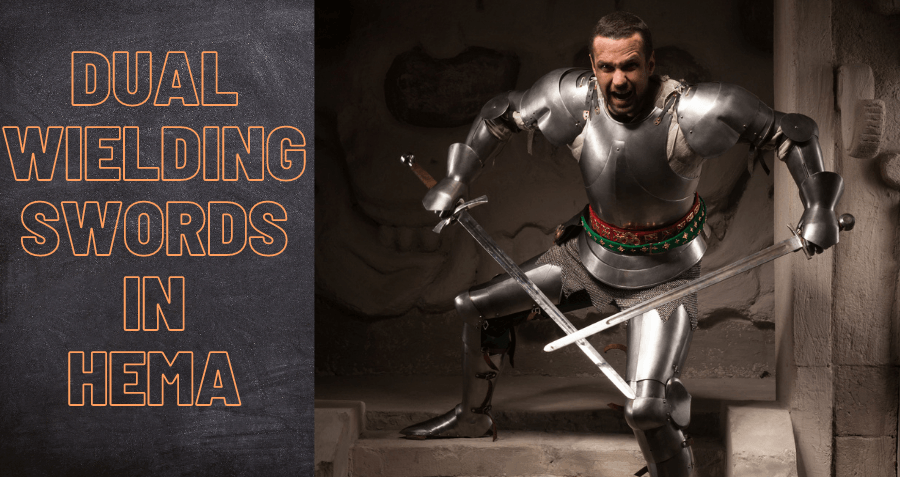The rapier as a word is probably one of the most widely used in the English language when talking about types of swords and swordsmanship. It is a staple of film and TV movies, appearing in everything from Zorro to the Three Musketeers to The Princess Bride. The “water dancing” swordplay depicted in the fictional series Game of Thrones is based loosely on the real life Spanish rapier sword fencing.
But what really is a rapier sword? How are they used?
Even within the broader HEMA community there can be confusion about this topic so let’s address a few of these misconceptions and answer some of the most common questions people have about rapiers in the process of doing so.
Misconception #1: Throughout history the word ‘rapier’ has always meant the same weapon.
The word ‘rapier’ is a loan word from the Middle French espee rapiere, a term that the earliest surviving recorded usage of dates from 1474 but likely was used earlier. The adjective is of uncertain origin, perhaps from derisive use of raspiere (“poker, scraper”) but has also been theorized to be based on the Spanish term “ropera” for wardrobe in relation to its common usage as a fashion accessory. Charles du Fresne wrote in Glossarium mediae et infimae Latinitatis (Glossary of medieval and late Latin) he encountered a form of the word as rapperia from a Latin text of 1511.
Regardless of the origin of the term, the word was used interchangeably with several other words that meant “sword”; some other examples being spada, espada, and épée (espée). This is one of the reasons why when researching ancient arms we cannot always go with the word itself when deciphering what weapon the author is referring to and need to look at other supporting information, such as description of characteristics of the weapon being discussed, although there are times when an author does specify the type of sword with labels such as espada ropera (Spanish for “dress sword”, recorded 1468), and spada da lato (Italian for “side-sword” also sometimes called spada da lato a striscia).
The wide range of terminology related to swords has often confused historians and must be considered when reading books about history, especially older ones.
To clarify things for you, in contemporary usage the term ‘rapier’ now exclusively refers to a long-bladed sword characterized by a protective hilt which is constructed to provide frontal protection for the hand while utilizing a philosophy of fighting first detailed in Camillo Agrippa’s 1553 manual Trattato di Scientia d’Arme, con vn Dialogo di Filosofia (“Treatise on the Science of Arms, with a Philosophical Dialogue”) and which evolved from the side-sword (spada da lato). Any sword without these specific characteristics is consequently not properly called a rapier sword anymore.

Misconception #2: The rapier sword is a very light easy to use weapon
A historically accurate rapier sword might be lighter than a long sword in terms of total weight, but used in the style described by historical fencing masters the rapier sword becomes much more physically demanding to wield than a long sword. This often surprises beginners to rapier fencing, as popular media (especially games like Dungeons & Dragons) often depict the rapier sword as having a lower strength requirement than a two handed sword.
In the real world outside of the imaginations of authors and screenwriters a long sword is generally held in two hands that share the weight, and its fighting style utilizes guard positions that are both low and high. Something that is not obvious to those with no experience in swordplay is that maintaining a high guard is a tiring activity whereas a low guard is generally not, and so by transitioning from high and low guard positions a long sword fencer can get a kind of “rest” to their arms by switching to a low guard for a moment during a duel before returning to a higher guard position.
By contrast the rapier sword is almost exclusively held in high guard positions above the chest with one hand extended out toward the opponent for nearly the entire match.

This means the rapier sword functions as a lever against the fencer’s wrist, multiplying its weight many times over as force exerted upon the extended arm. Specifically, when held the index finger is wrapped just under the ricasso and becomes a fulcrum for the lever. During the act of fencing against an opponent the general objective is to utilize the strongest part of your blade (forte) as a lever against the weak (debole) part of the fencer’s blade, thereby multiplying the force exerted upon the arm which makes the blade in effect, far heavier and consequently places the opponent in a position of mechanical disadvantage where they cannot attack. So while the total mass of a rapier might be as low as 2.2 lbs when sitting on a weight scale, the actual force exerted on your arm during a fencing match can be a hundred-fold of that.

(The diagram above illustrates what parts of the blade are meant by ‘weak’ and ‘strong’.)
On top of this rapier sword fencing is primarily centered around the goal of thrusting your tip into your opponent using a lunging attack, and many of these lunges can require a moderate to high amount of agility. They all require a high amount of stamina as repeatedly performing these lunges during a class can quickly tire one out.

In schools that teach both rapier and long sword fencing it is not uncommon for rapier sword classes to be taught earlier in the day and the long sword class to come after because using a long sword actually gives your muscles a’bit of a break in comparison to the rigorous demands of rapier combat upon your body.
To further clarify, a raper is not actually used by swinging it around in the “swashbuckling” fashion that is typically depicted in popular movies and video games. As an example take this scene from The Princess Bride,
While a terrific movie and visually entertaining, the swordplay it depicts has nothing to do with historical rapier fencing. The Princess Bride utilized modern stage fighting designed to impress and delight spectators, as nearly every movie, TV show and video game does when depicting rapier fencing. Historical fencing practices are almost never shown in this kind of media.
Rapier sword fencing actually looks like this when following the styles utilized by the source material studied by Historical European martial artists.
It is still impressive in our opinion, just in a very different and more real way.
Misconception #3: Small-swords and foils are rapiers swords
Foils, at least in the contemporary usage of the term for sport fencing, are a very different weapon than a historical rapier is. It does not behave in the same way as it is essentially a thin wire bar capable of bending in ways that no historical rapier is able to, while weighing so little that it becomes impossible to fully utilize all of Camillo Agrippa’s principles. Consequently a foil is not a rapier simulator.
What a foil is actually intended to be is a smallsword simulator, or rather it was until the modern foil became so flexible it no longer behaves like a small sword, either.
Explaining this by prose alone may not be sufficient. Here is a video with slow motion footage and rotoscoping that shows two fencers in motion. Take note of times in the video where the blades do movements such as bending around the opponent’s guard with a flick to strike, or bending with a flick to attack the opponent’s back. These are movements that neither a rapier nor a smallsword can do as they depend upon a level of extreme blade flexibility that would make many rapier and small sword techniques that depend upon leverage not possible to do. Furthermore a rapier is a very stiff blade and does not bend easily, as its objective is to maximum penetrative force during the thrust. A blade with this much bend cannot be used effectively in rapier fencing.
Now on the other hand a smallsword is basically just a shorter bladed rapier with a less decorative handle. They were cheaper to make and easier to carry in daily life due to a shortened length, but for all intents and purposes they were originally used like a rapier was.

If you really get into the history of it all the distinct methods of small sword fencing developed among fencers wishing to use the same sportified version of rapier fencing developed in the French court to perform duels with live blades and like the rapier it was considered a civilian dress sword, not a weapon intended for the battlefield. The battlefield sword of the time was the sabre.
This can get confusing, so read the following carefully; the rapier was developed originally as a lethal weapon but over time its usage became a past time and hobby — a sport — among the nobility, especially the French. Within the French courts developed a blunted rapier practice trainer with blade flexibility and a shorter length (presumably to lessen the amount of force a thrust directed, as a long blade multiplies the transfer of momentum by virtue of its additional weight).
This practice weapon was called a fleuret in French, which became foile in English, but it’s not the same foil used by modern sport fencers. While these fleuret possess blade flexibility in the thrust to help prevent injury they do not flex as much as modern foils do. The kind of rapiers modern day historical fencers utilize are similar to the historical fleuret although we utilize modern day steel manufacturing and heat treatment methods that allow for a near perfect rapier simulator.


Now while you can do generally all the same techniques using a small-sword as you can with a rapier, there developed a distinct method of fighting with the small-sword that evolved from rapier fencing in the courts of France as rapier fencing became more of a sport, shaped by its rules more so than the realities of real combat. This evolution eventually would result in the practice weapon for the small-sword, the foil, becoming the predominant archetype for which modern sport fencing developed the modern day foil, epee and sabres it utilizes today.
If the subject of small swords and its transition into modern sport fencing interests you, please check out our dedicated Path of the Small-sword page for additional information.
Misconception #4: A rapier sword cannot cut, only thrust.
This is a misconception among people who are generally aware of how a rapier was historically used but lack the experience of using one themselves so this minutia is overlooked by them.
A rapier has a sharpened blade just like any other sword does. That means it can be used to cut.
Cuts are mentioned in several historical fencing treatises; as an example ,
- Francesco Alfieri depicts cuts in La Scherma di Francesco Fernando Alfieri (“The Fencing of Francesco Fernando Alfieri”) .
- Ridolfo Capoferro devotes a section of Gran Simulacro dell’Arte e dell’Uso della Scherma (“Great Representation of the Art and Use of Fencing”) to the topic of cuts.
- Nicoletto Giganti also discusses cuts in Libro secondo di Niccoletto Giganti (“Second Book of Niccoletto Giganti”).
Now there are some late period rapiers which forwent sharpening the strong of the blade but they did typically still sharpen the weak.
Cuts can and are delivered as part of historical rapier fencing. Even if the length of the blade is not always sharp on late period rapiers the tip always is, as that is the primary point used to attack. Tip cuts can be just as effective against lightly armored opponents, and duels were typically done in civilian dress.
Now what seems to confuse people is that wide rapier cuts are usually not done during actual rapier swordplay because the wider your strike the more easier it is for your opponent to counter you. Cuts in rapier sword fighting tend to be very small circular movements in comparison to the wider cuts delivered in the long sword traditions.
Misconception #5: Rapier blades are super easy to snap.
This misconception somewhat stems from depictions in movies, and somewhat comes from HEMA practices.
For movies and TV shows you see sometimes a rapier getting broken by another sword as part of a gag, which generally doesn’t happen when any blade clashes with another blade unless the steel is of such vastly better quality than the other and even then it’s not like it’s going to just take a single blow to break it (unless the blade that breaks already had structural damage to it from prior usage). Sword blades of all kinds definitely can fail during battle but it’s harder to do it than popular media depicts it as being.
In the case of HEMA the situation is a’bit different. Our practice blades are designed to be able to flex, and while flexing a blade almost never will break it the manner in which the blade snaps back into place is another story.
The reason you see sword manufacturers demonstrate the flexibility of a sword blade flexing against its flat with a vice by slowly bending the blade and then controlling it as it returns to a straight shape is to prevent an enormous amount of force in an uncontrolled snap back from causing the blade to shatter.
Since HEMA combat is done at high speed at times a blade can flex and then snap back with so much force it fails, breaking the blade.
This can happen to any of the flexible practice blades used by Historical European fencers and it is not unique to rapiers. Blades can also break in HEMA fencing for other reasons, primarily due to heat treat problems in the blade, but the point here is being flexible doesn’t make a blade more prone to breaking; it’s the snapping back of the blade from an extreme bend that tends to lead to breaks in an otherwise good blade.
Partial Bibliography
Rapier.Wikipedia [Online] Available at: https://en.wikipedia.org/wiki/Rapier [Accessed 30 May 2020]
In Summary
We hope this article has cleared up some of your misunderstandings and explained things clearly. If you have any questions or something you’d like to contribute, feel free to comment below.
If you’d like to learn how to use a rapier, please check out the following articles on our site.
If you’d like to learn more information about historical fencing practices please check out our Learn HEMA page for a guide to learning about the historical weapon that interests you. You can also find more guides we’ve written about other topics at our Helpful Guides page. You can also join the conversation at our forums or our Facebook Group community.
















